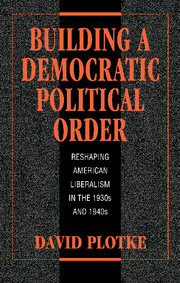Book contents
- Frontmatter
- Contents
- Preface
- Introduction: The Democratic order as a political project
- 1 When does politics change?
- 2 Creating political orders: the logic of the Democratic experience
- 3 Democratic opportunities in the crises of the 1930s
- 4 Passing the Wagner Act and building a new Democratic state
- 5 Party and movements in the Democratic upsurge, 1935–7
- 6 Progressive liberalism as pragmatic common sense
- 7 Surprising years: electing Truman and sustaining the Democratic order, 1947–9
- 8 Passing Taft-Hartley: what the losers won (and what the winners lost)
- 9 New political fronts? growth and civil rights in the 1940s
- 10 Democratic anti-Communism and the Cold War
- 11 From Truman to Kennedy: the reach and limits of Democratic power
- 12 Was the Democratic order democratic?
- Index
2 - Creating political orders: the logic of the Democratic experience
Published online by Cambridge University Press: 17 September 2009
- Frontmatter
- Contents
- Preface
- Introduction: The Democratic order as a political project
- 1 When does politics change?
- 2 Creating political orders: the logic of the Democratic experience
- 3 Democratic opportunities in the crises of the 1930s
- 4 Passing the Wagner Act and building a new Democratic state
- 5 Party and movements in the Democratic upsurge, 1935–7
- 6 Progressive liberalism as pragmatic common sense
- 7 Surprising years: electing Truman and sustaining the Democratic order, 1947–9
- 8 Passing Taft-Hartley: what the losers won (and what the winners lost)
- 9 New political fronts? growth and civil rights in the 1940s
- 10 Democratic anti-Communism and the Cold War
- 11 From Truman to Kennedy: the reach and limits of Democratic power
- 12 Was the Democratic order democratic?
- Index
Summary
This chapter outlines the development of the Democratic order. Analyzing the construction of a new political order in the United States in the 1930s and its endurance through the next decade requires an overall conception of how political orders are built and sustained, and why they decline. Absent such a conception, it is hard to explain the relation between the origins of the Democratic order and the end of the preceding Republican regime. And it is hard to account for the persistence of Democratic power after Roosevelt's death. Thus the argument in this chapter concerns the whole period of Democratic domination, from the 1930s through the 1960s. And it is based on a general account of political orders. Regimes, or political orders, are central in shaping political life in advanced market societies. Serious conflict arises over many issues, from cultural differences to economic choices to questions about how to organize political institutions. This conflict leads to major changes that are usually combined in a new regime. The new regime defines a normal political spectrum and routine modes of competition.
In building a political order, a major mobilization of party, movement, and other forces reshapes the state and the normal terms of political argument and conflict.
- Type
- Chapter
- Information
- Building a Democratic Political OrderReshaping American Liberalism in the 1930s and 1940s, pp. 47 - 76Publisher: Cambridge University PressPrint publication year: 1996



